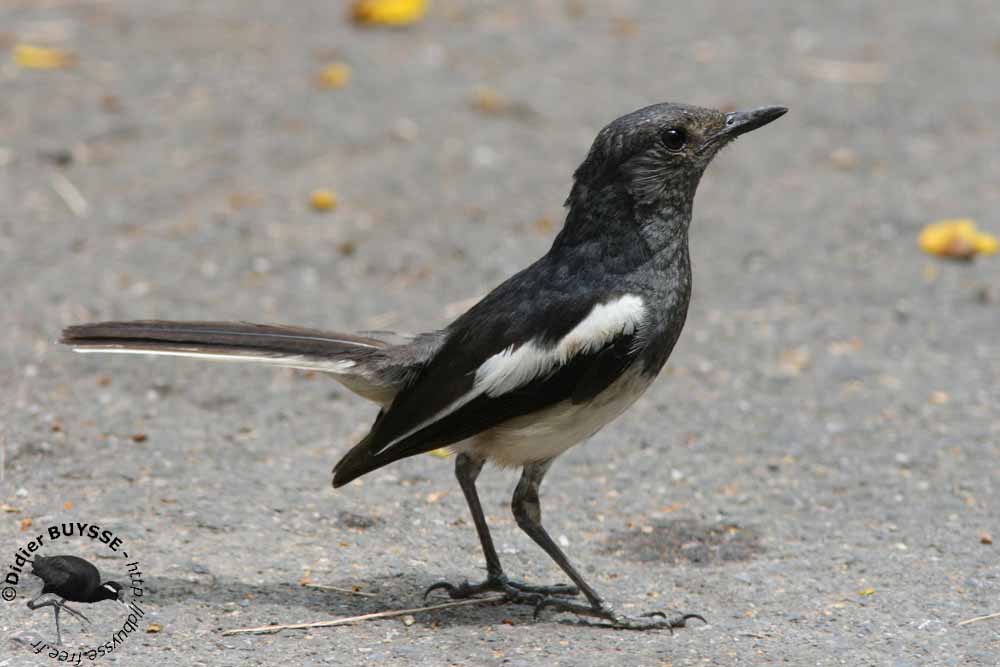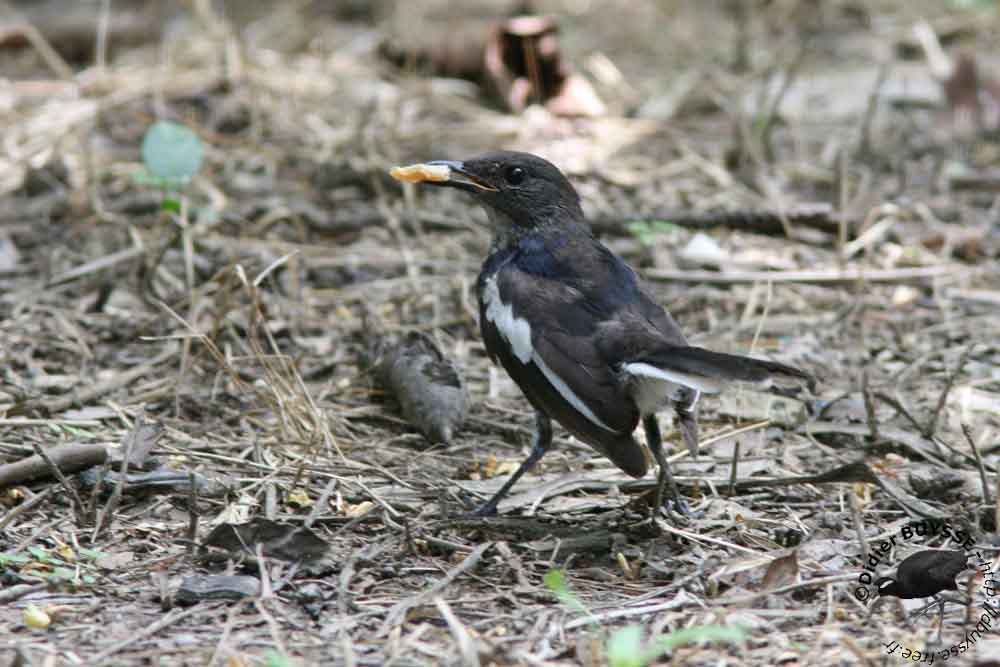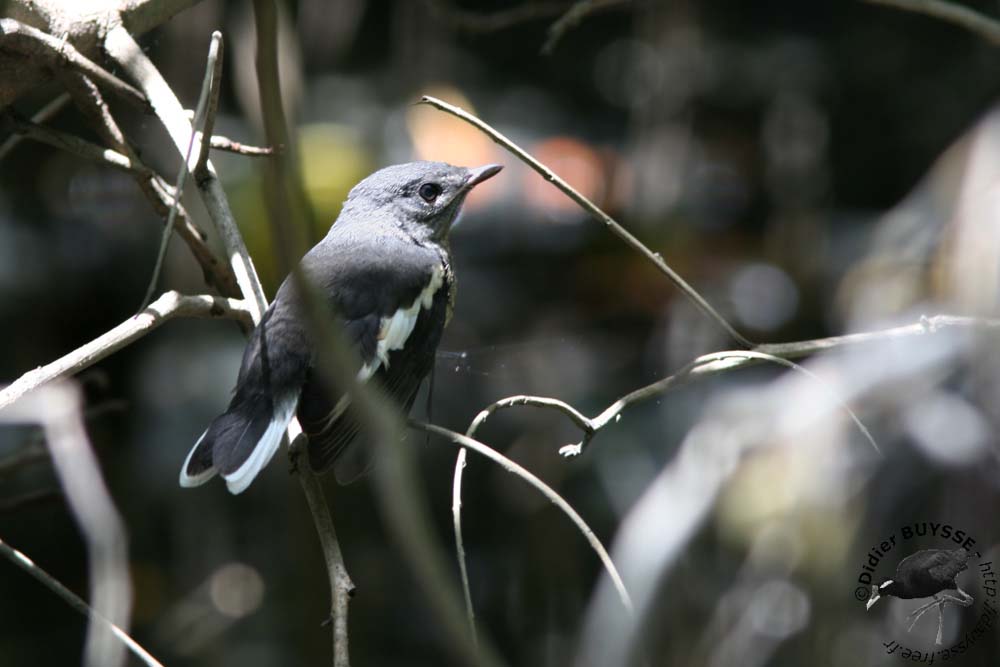
Oriental Magpie Robin
Copsychus saularis
Passeriforme Order – Muscicapidae Family
BIOMETRICS:
Length: 19-23 cm ; Weight: 31-42 g
DESCRIPTION:
Oriental Maggie-Robin male has glossy blue-black upperparts, head, throat and upper breast. Long tail is black, with white outer feathers. Wings are black with two bold, long, white wing bars. Underparts are white.
Bill is black. Eyes are dark. Legs and feet are blackish.
Female is dull dark grey instead black on the same body parts.
Juvenile resembles female, but it has scaly head and upperparts, and mottled brown throat and breast.
VOICE: SOUNDS BY XENO-CANTO
Oriental Magpie-Robin utters beautiful clear whistles at dawn, repeated on short phrases. It is able to imitate other birds’ calls.
Its melodious song is strong and varied, with discordant notes and mimicries. They sometimes may abruptly sing during the night.
HABITAT:
Oriental Magpie-Robin is common in parks and gardens. It is found in cultivated areas and open woodlands. It also frequents human habitation surroundings. It can be found up to 2000 metres in bushes, but also in coastal mangroves.
RANGE:
Oriental Magpie-Robin is resident and breeds in India, Southern China, South-eastern Asia, Indonesia and the Philippines.
BEHAVIOUR:
Oriental Magpie-Robin searches for food on the ground, hopping with raised tail and foraging for preys. It also feeds in trees.
This bird is often perched on exposed places, with raised tail and dropped wings. It is sprightly and lively.
Courtship displays show the male giving hearty song, often at dawn and dusk. While singing, it moves the tail up and down in synchrony with the tune. At this period, male is often perched on treetops and sings.
It can become very territorial during breeding season and it is very possessive of its territory which it protects jealously. Intruders are rebuffed with aggressive display showing the male with puffed out plumage, pointed bill upwards, and strutting and posturing in front of the opponent. It may utter discordant calls while chasing intruders away from its territory.
They live solitary, in pairs or in family groups, about human habitations. This species is rather shy and silent outside of breeding season.
Oriental Magpie-Robin uses two kinds of communication behaviour: first, vocal, by songs and calls; then, by posturing: wagging the tail, pecking, submission, begging posturing, body presentation and flying (Ms. Auttpol Nakwa).
FLIGHT:
Oriental Magpie-Robin flies often near the ground, only on short distances. It is a terrestrial bird.
REPRODUCTION:
Oriental Magpie-Robin breeds from February to August. Its nest is located in a cavity, a hole in tree, in a wall, in a building, a ledge under a roof, or any place near humans. Nest can also be built in thick shrubs, in forks of branches in a small tree, even in an old tin can.
Nest is a loose open cup usually built low. It is large, untidy, made with grass and dried leaves, twigs, moss and roots. Interior is lined with fibres or grass.
Female lays 3 to 5 pale greenish-blue eggs, spotted with reddish. Incubation lasts about 12 to 13 days, by both adults. Both parents raise the young which remain in the territory until the next breeding season.
DIET:
Oriental Magpie-Robin feeds mainly on insects caught on the ground, and also flower nectar. It also consumes earthworms, snails, small lizards and some plant matter.
PROTECTION / THREATS / STATUS:
Oriental Magpie-Robin continues to be trapped for the caged- bird trade.
This species is relatively common in most parts of its range. It is native from Singapore, and after to be pushed to near extinction in the 1970s, it was reintroduced in the 1980s. But species remains vulnerable.
It is common in Hong Kong and in Bangladesh where it is the National Bird.
Oriental Magpie-Robin is now protected by law.
Fr: Shama dayal
All : Dajal
Esp: Shama Oriental
Ital : Merlo gazza
Nd : Dayallijster
Russe : Сорочья славка
Sd : Skatnäktergal
Photographs by Didier Buysse
His website:
Vision d’Oiseaux
Text by Nicole Bouglouan
Sources:
HANDBOOK OF THE BIRDS OF THE WORLD Vol 11 by Josep del Hoyo, Andrew Elliott and David Christie - Lynx Edicions - ISBN: 849655306X
LES OISEAUX DE THAILANDE par Roland Eve et Anne-Marie Guigue - Times Editions - ISBN: 9812042008
Wikipedia (Wikipedia, The Free Encyclopedia)
Arthur Grosset's Birds (Arthur Grosset)


